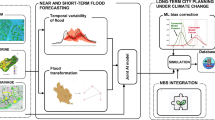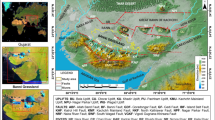Abstract
The importance and role of vegetation on the ecological structure and urban environment is well known. The general theme of this research was maintaining, equipping, and improving the area for recreational use, connecting ecological urban forest network, and maintaining green belt continuity of Tehran for limiting the urban sprawl. At first, we surveyed the ecological and socio-economic resources. Then, the data were integrated to depict mapping unit. In these homogeneous units, the interaction of ecological resources was classified by varied typed. On the basis of surveyed resources, special model of area based on general model of ecotourism (the Iranian model of Makhdoum) was prepared. According to the designated model, the ecological capability evaluation was conducted for ecotourism use. From the levels of 40,400 ha on southern aspects of Alborz mountains of Tehran (and based on an ecological capability evaluation model) intensive recreation capability of class 2, extensive recreation capability of class 1, and extensive recreation capability of class 1 were classified (1309 ha, 1802 ha and 28,275 ha, respectively). To determine the appropriate area for allocation to the forest recreation, zoning was performed. Detailed mapping was carried out. Then, the area was allocated with 28 ha for design. After the execution of popular lookout and determination of the relative quality of views in the designated area, design of specific site with considering the ecological, social, cultural, and ecological aspects of landscapes was conducted. The programming in the frame of a management plan was founded and a proposed program was presented.





Similar content being viewed by others
References
Arnberger, A. (2006). Recreation use of urban forests: An inter-area comparison. Journal of Urban Forestry and Urban Greening, 4, 135–144. https://doi.org/10.1016/j.ufug.2006.01.004.
Barzehkar, G. (2005). Forest parks and recreational areas (determining location and planning) (1st ed.). Tehran: Agriculture and Natural Resources Engineering Organization.
Barzehkar, G. (2007). Forest parks planning manual (1st ed.). Qarchak: Ashk-e-Ghalam.
Brown, R., Vanos, J., Kenny, N., & Lenzholzer, S. (2015). Designing urban parks that ameliorate the effects of climate change. Journal of Landscape and Urban Planning, 138, 118–131. https://doi.org/10.1016/j.landurbplan.2015.02.006.
Brown, G., & Weber, D. (2011). Public participation GIS: A new method for national park planning. Journal of Landscape and Urban Planning, 102, 1–15. https://doi.org/10.1016/j.landurbplan.2011.03.003.
Dahmann, N., Wolch, J., Joassart-Marcelli, P., Reynolds, K., & Jerrett, M. (2009). The active city? Disparities in provision of urban public recreation resources. Journal of Health and Place, 16, 431–445. https://doi.org/10.1016/j.healthplace.2009.11.005.
Darabi, H., & Saeeidi, A. (2013). Ecological designing of Forest parks (case study: Shahid-Beheshti Forest Park, Boroujerd). Journal of Environmental Studies, 2, 1–10.
Gharshi, S. (2003). Designing of Sysngan natural forest park with an emphasis on people preferences. M.S. Thesis on Environmental Designing, Environmental College, University of Tehran.
IraniBehbahani, H., & Razi-Moftakhar, N. (2005). Sustainable designing of developing Sheikh-Tapeh Forest Park, Urmia. Journal of Environmental Studies, 37, 89–104.
Itami, R., Raulings, R., MacLaren, G., Hirst, K., Gimblett, R., Zanon, D., et al. (2003). RBSim 2: Simulating the complex interactions between human movement and the outdoor recreation environment. Journal of Nature Conservation, 11, 278–286. https://doi.org/10.1078/1617-1381-00059.
Jamshidi, A. (2009). Environment and landscape-centering designing of the East Isfahan Belt with an emphasis on urban tourism. M.S. Thesis on Environmental Designing, Environmental College, University of Tehran.
Makhdoum, M. (1987). Comprehensive plan on park management of National Parks of Sorkheh-Hesar, and Khojir. Department of Environment.
Makhdoum, M. (2010). Fundamental of land use planning (9th ed.). Tehran: University of Tehran.
Makhdoum, M. (2011). An instruction for preparation of national and forest parks and nature parks (1st edn). Academic Publication Center.
Makhdoum, M., Darvish-Sefat, A., & Makhdoom, A. (2011). Environmental evaluation and planning using geographic information systems (GIS) (3rd ed.). Tehran: University of Tehran.
Mexia, T., Vieira, J., Principe, A., Anjos, A., Silva, P., Lopes, N., et al. (2018). Ecosystem services: Urban parks under a magnifying glass. Journal of Environmental Research, 160, 469–478. https://doi.org/10.1016/j.envres.2017.10.023.
MichaeliTabrizi, A. (2004). Organization of recreational and leisure planning. Gorgan: Gorgan University of Agricultural Sciences and Natural Resources.
Mirkarimi, H. (1994). Engineering designing and boundary determining of Cheetgar Forest Park. M.S. Thesis on Environmental Sciences, Natural Resources College, University of Tehran.
Nahuelhual, L., Carmona, A., Lozada, P., Jaramillo, A., & Aguayo, M. (2013). Mapping recreation and ecotourism as a cultural ecosystem service: An application at the local level in Southern Chile. Journal of Applied Geography, 40, 71–82. https://doi.org/10.1016/j.apgeog.2012.12.004.
Norouzifar, T. (2007). Designing and environmental organizing of Lavizan Forest Park. M.S. Thesis on Environmental Designing, Environmental College, University of Tehran.
Rashidi, A., Makhdoom, M., Feghhi, J., & Sharifi, M. (2010). Evaluation of ecotourism in the forests surrounding Zaribar wetland using geographical information system (GIS). Journal of Environmental Researches, 2, 19–30.
Sharifi, M. (2010). Park creating and forest park management with ecotourism development approach (1st ed.). Tehran: University of Tehran.
Teh, L., & Cabanban, A. S. (2007). Planning for sustainable tourism in southern Pulau Banggi: An assessment of biophysical conditions and their implications for future tourism development. Journal of Environmental Management, 85, 999–1008. https://doi.org/10.1016/j.jenvman.2006.11.005.
Zheng, Y., Lan, S., Chen, W. Y., Chen, X., Xu, X., Chen, Y., et al. (2019). Visual sensitivity versus ecological sensitivity: An application of GIS in urban forest park planning. Journal of Urban Forestry and Urban Greening, 41, 139–149. https://doi.org/10.1016/j.ufug.2019.03.010.
Author information
Authors and Affiliations
Corresponding author
Additional information
Publisher's Note
Springer Nature remains neutral with regard to jurisdictional claims in published maps and institutional affiliations.
Rights and permissions
About this article
Cite this article
Mahmoudkhani, M., Feghhi, J., Makhdoum, M. et al. Evaluation of the recreational capability and designing of the woodsy promenade. Environ Dev Sustain 23, 8062–8075 (2021). https://doi.org/10.1007/s10668-020-00947-z
Received:
Accepted:
Published:
Issue Date:
DOI: https://doi.org/10.1007/s10668-020-00947-z




